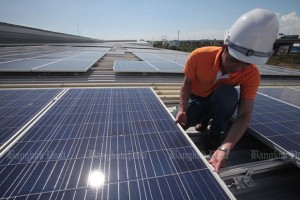The International Energy Agency’s (IEA) report on Southeast Asia sees 74 per cent of the region’s power coming from fossil fuels by 2040, with Indonesia and Vietnam supplying coal
Firstly, commercial clean coal technology (CCT) does not exist. Globally, no CCT can compete in price with alternatives like solar and, at the same time, remove the CO2 and other gases such as sulphur dioxide and nitrogen oxide, process the toxic metal by-products, and capture the particulates. Hundreds of Thais die prematurely every year from coal, and if the Songhkla and Krabi plants go ahead, thousands more will be killed. Also, coal mining degrades the environment and affects the livelihood of tens of thousands of people.
Secondly, the IEA’s report assumes global warming of 2C. However, data from Climate Central, an independent organisation which conducts climate warming modelling, shows that a 2C increase will cause a 4.7-metre rise in sea levels. Given that much of Bangkok is at the 4-metre level, the report implies the loss of Bangkok as a viable capital. Relocating affected businesses and ministries would cost trillions of baht – which the report ignores.
A third point is the government’s commitment to energy independence. Present planning documents call for 80 per cent energy independence by 2030. However, reliance on foreign coal as well as on foreign hydro and gas, all of which outsource environmental costs to our Asean neighbours, means that energy independence could be as low as 60 per cent.
The government cannot claim to be promoting national energy security while planning to import that much energy.
The IEA report itself admits that the 2C goal would require additional technologies and policies and calls for a massive investment in alternative technologies across the region from $270 billion (Bt9.6 trillion) in 2014 to $400 billion in 2030. In Thailand, where the majority of this money should be going is clear.
It should be going into solar. One reason is the worldwide economics of solar are now in place. Virtually all of Thailand, according to SolarGIS, a solar data simulation organisation, is suitable for producing solar-generated electricity using photovoltaics.
The mass production of increasingly efficient solar cells by China following Swanson’s Law, a solar version of Moore’s Law for computer processing power, means the levelised cost of electricity from solar will be Bt2.5-Bt2.6 per unit by 2036, while coal will be Bt2.6-Bt3, according to the German Fraunhofer Institute for Solar Energy Systems.
Furthermore, storage technology for solar is coming online at competitive prices. One of the simplest technologies for storing electricity is hydroelectric pumped storage. Basically, water is pumped up a hill into a reservoir during daylight, then allowed down the hill, driving a turbine as it goes, at night. More sophisticated technologies include compressed-air storage, using a similar principle and effective in areas with few hills, such as Thailand’s Northeast.
Moreover, home battery systems using lithium ion are now emerging, such as the Tesla Powerwall, with developments in technology including all-climate batteries and lithium superoxide cells, which have five times the energy density of conventional lithium ion. These in turn will drive transport innovations, with the world’s first mass-produced electric car, General Motor’s Bolt, due to be released late this year, as well as urban-level battery storage for 5-10MW modular plants.
There is no sign of any awareness of this future in Thailand’s national energy planning, such as the Energy Ministry’s Integrated Energy Blueprint (IEB). Currently, the IEB estimates 6,000MW of installed solar capacity by 2036. However, this figure is not supported by statistics. The research company BMI predicts solar expanding by 13.2 per cent per year on average from 2015-25 – meaning 8,600 MW by 2025 alone. Assuming a lower rate of increase of 6.6 per cent from 2025-2036, there will be 18,000MW of installed solar – enough to retire coal-fired power plants except as back-ups.
The IEB covers five areas: energy efficiency, power, and alternative energy development plans, together with gas and oil road maps. The obvious omission is a separate road map for solar. The core for this road map should be a revamped framework for ground-mounted solar energy projects using power-purchase agreements under the Energy Regulatory Commission. As well as developing the energy grid to support feed-in, a solar road map would create a clear licensing framework which would exclude no-name companies and insist on deadlines for completion, to avoid creating a secondary market, as with past licensing debacles.
Furthermore, the country must plan to build not hundreds but thousands of 5MW community solar farms and thereby decentralise the energy industry. In the Northeast, farmers are looking at parched landscapes. They are more than ready to begin solar farming, a phenomenon that has taken off in Greece and assuaged the poverty there. As a very basic goal, Thailand can convert all its major university campuses to solar or alternatives, through the building of modular plants. If this cannot be accomplished in a semitropical country over the next 10 years, something is very wrong with either the administration or the bureaucracy.
Finally, Thailand needs to develop large solar power stations of over 500MW for large urban centres and industries, as in China and India. Along the way, Thailand will implement cutting-edge photovoltaic cell and storage technology, innovating its way out of the upper-middle income trap as it does so – instead of buying into a pro-coal paradigm using an illusory technology which is both short-sighted and ultimately destructive.
There can be no easier way for the military to leave a worthy legacy and so endear itself to the public. The alternative is a collapse in confidence.
Source: http://www.nationmultimedia.com/opinion/Give-us-solar-road-map-to-avoid-doomsday-scenario-30279099.html


